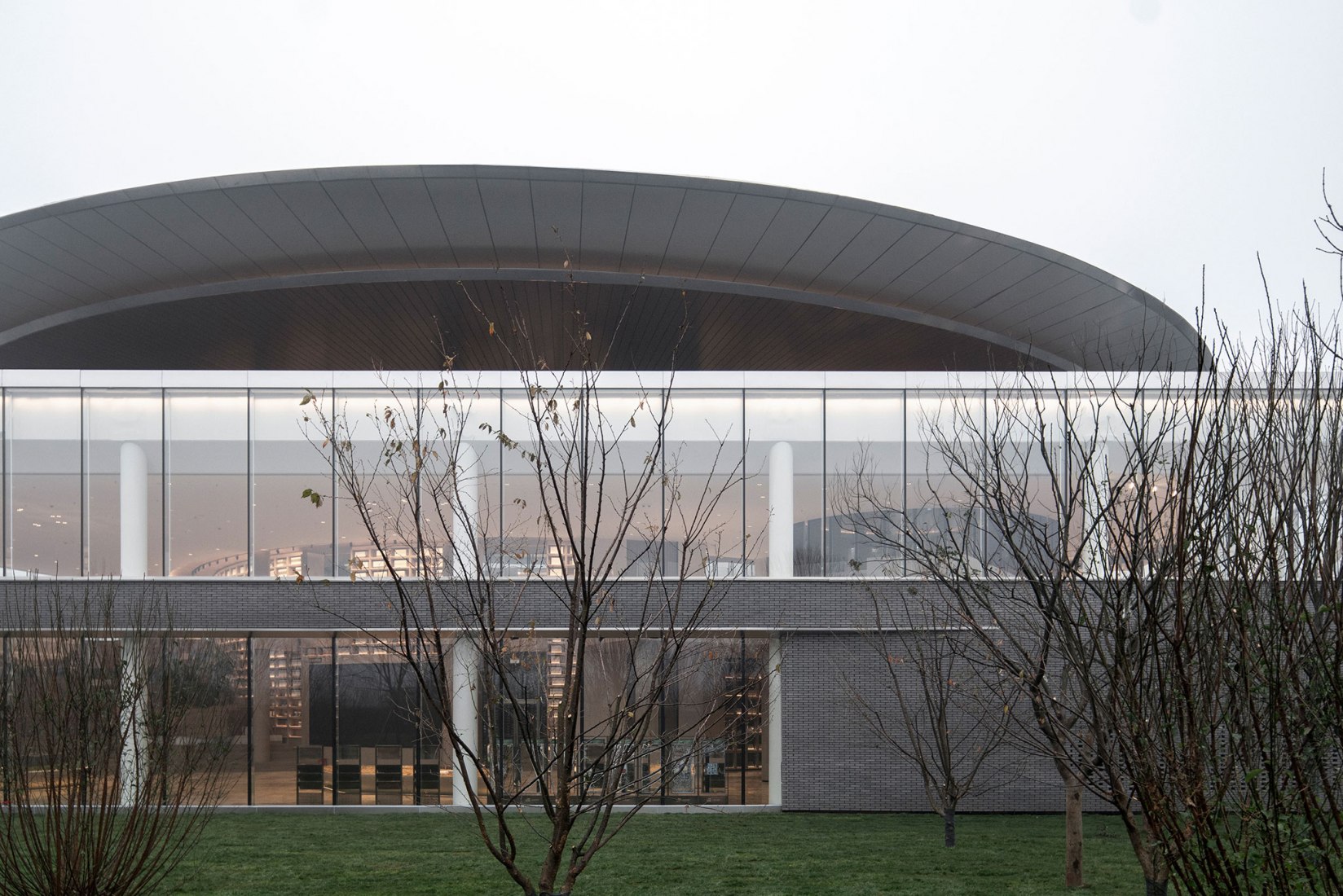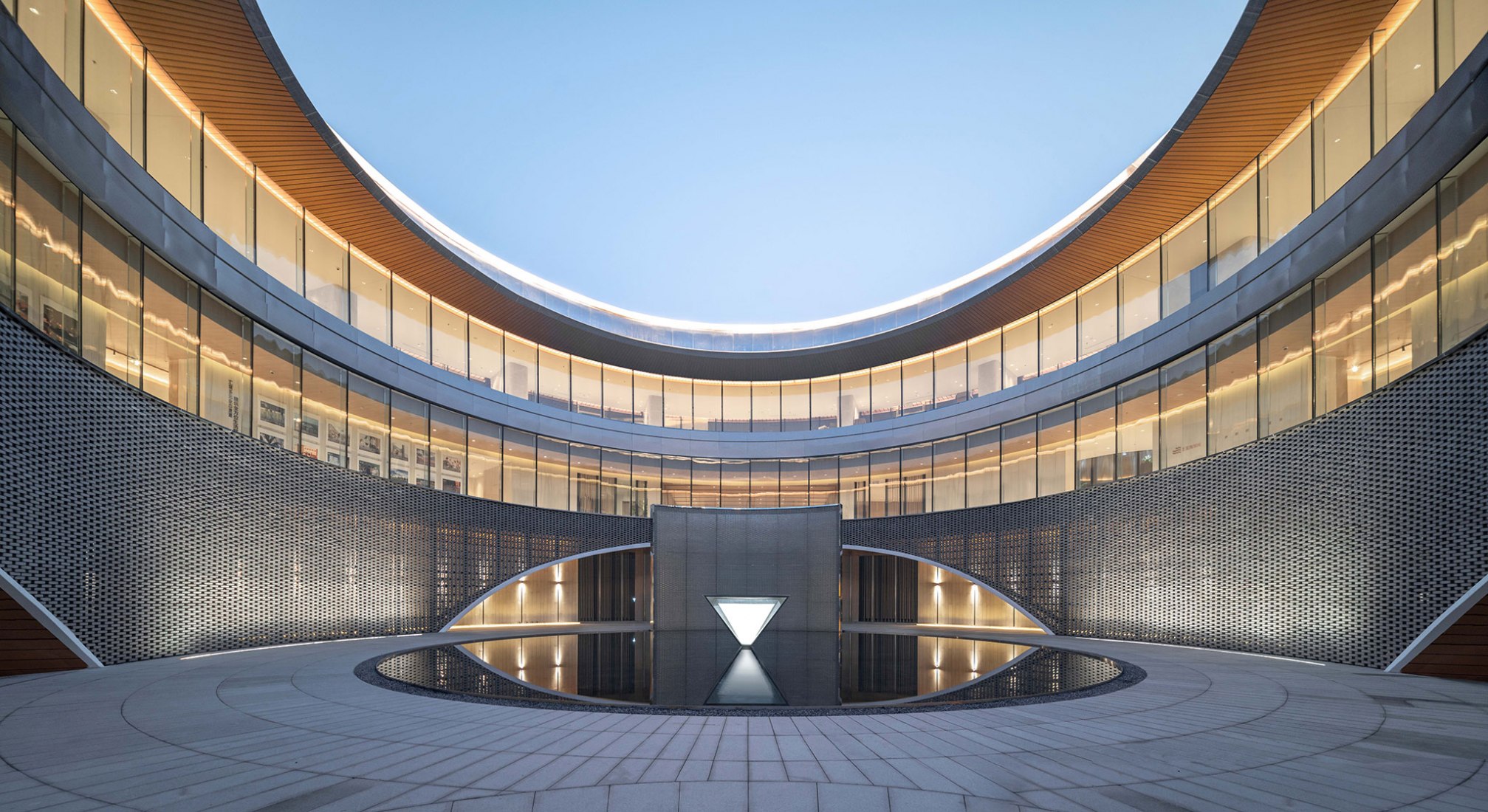The building also has two openings, one in the garden to the west and the other to the sky. The internal circular space is derived from the concept of a traditional Chinese courtyard. This connects heaven and earth, allowing to awaken the thoughts and spirituality of those who visit it.
Project description by Lacime Architects
The project is located at the future land-air transport hub of Henan, which will be the core of future urban southward expansion plan. Architects consult the Rites of the Zhou•Records on the Examination of Craftsmanship in the preliminary planning and design process and integrate local symbols of the Central Plains Culture in an attempt to build a “paradise city with national customs” in Zhengzhou.
The planning logic of “south garden and north yard” is followed for the whole area in this project. Ideas of Chinese ancient garden construction were introduced into the “south garden”, make the most important building the starting point of the entire array. It becomes a city-level public parlor in an open form. Moreover, the building facade is presented in the shape of arc to match the main garden in the front.
Architects desire to show the relationship between the building and Chinese traditional worldview, and finally creates the form of “three arcs, two entrances and one beam of light”. Time and space have formed between the first vaulted arc and the second square arc. The third entrance arc is the central focus of the whole façade array. When the building is reflected in water, the virtual-real arcs make up an eye that seems to target where time and space meet.
The building has two openings: one is the west-facing garden and the other faces the sky. The entrance guides people inwards, yet it sparks thoughts when people look up at the sky. The internal round space is derived from the concept of “courtyard” in Chinese traditional architecture. Unlike external and internal spaces, the courtyard connects the sky and the earth and creates another “realm” for the building space, allowing time and space meet here.
In the center of the atrium lies the artistic installation “time container” designed by us. Standing in the center of the space, it complements with the round courtyard in the shape of pyramid, which works together with reflections to indicate the passage of time like an hourglass.
We hope to maintain unique oriental beauty in form and materials, so “simplicity” and “subtlety” have become the keywords that match glossiness and fusion. Compared with plain beauty, the texture of simplicity is more reserved. When it comes to glossiness, we choose a range of matte-finish materials like frosted earthenware tile, matte composite aluminum-plastic sheet and brushed stainless steel, and make them properly combined according to their glossiness.
The first floor of the building is composed of external square tile wall featuring the straight-curved layout and internal cylinder-shaped tile wall. It is built from 100 thousand earthenware tiles. It is the wall combining large-scale staggered arrangement and gradual hollowed-out design in some areas to achieve the gradient effect of textures. Besides, the acute-angle contraction is done for the joint of the corner and window, which makes the details more forceful.
The arched suspended ceiling structure is the space truss system. It is not only the keel of the main curtain wall for the wooden-grained arched suspended ceiling, but also part of the load-bearing structure of the building’s main structure. Its top part supports large-step space inside the building as well as the dual-pillar system for the third-floor roof overhang. That is also the challenge of the entire architectural structure.
To attain the best result in overhang size, light weight and thinness, the design adopt two innovative structural systems-cylinder-shaped dual-pillar system and composite roof truss system. As a result, the overhang is up to 12 meters, and the thinnest part is only 15cm. Architects use the dark-slate-blue Al-Mg-Mn standing seam roof, so it can fit well with the sky and earth from the bird’s-eye view.
---
El proyecto está ubicado en el futuro centro de transporte terrestre-aéreo de Henan, que será el núcleo del futuro plan de expansión urbana hacia el sur. Los arquitectos consultan los Ritos del Zhou • Registros sobre el examen de la artesanía en el proceso preliminar de planificación y diseño e integran los símbolos locales de la Cultura de las Llanuras Centrales en un intento de construir una “ciudad paradisíaca con costumbres nacionales” en Zhengzhou.
La lógica de planificación de "jardín sur y patio norte" se sigue para toda el área en este proyecto. Las ideas de la construcción de jardines antiguos chinos se introdujeron en el "jardín sur", convirtiendo el edificio más importante en el punto de partida de todo el conjunto. Se convierte en un salón público a nivel de ciudad en forma abierta. Además, la fachada del edificio se presenta en forma de arco a juego con el jardín principal del frente.
Los arquitectos desean mostrar la relación entre el edificio y la cosmovisión tradicional china, y finalmente crean la forma de “tres arcos, dos entradas y un rayo de luz”. El tiempo y el espacio se han formado entre el primer arco abovedado y el segundo arco cuadrado. El tercer arco de entrada es el foco central de todo el conjunto de fachadas. Cuando el edificio se refleja en el agua, los arcos virtuales-reales forman un ojo que parece apuntar donde el tiempo y el espacio se encuentran.
El edificio tiene dos aberturas: una es el jardín al oeste y la otra al cielo. La entrada guía a la gente hacia el interior, pero despierta pensamientos cuando la gente mira hacia el cielo. El espacio circular interno se deriva del concepto de "patio" en la arquitectura tradicional china. A diferencia de los espacios externos e internos, el patio conecta el cielo y la tierra y crea otro "reino" para el espacio del edificio, permitiendo que el tiempo y el espacio se encuentren aquí.
En el centro del atrio se encuentra la instalación artística “contenedor del tiempo” diseñada por nosotros. Situada en el centro del espacio, se complementa con el patio circular en forma de pirámide, que trabaja junto con los reflejos para indicar el paso del tiempo como un reloj de arena.
Esperamos mantener la belleza oriental única en la forma y los materiales, por lo que la "sencillez" y la "sutileza" se han convertido en las palabras clave que combinan brillo y fusión. En comparación con la belleza simple, la textura de la simplicidad es más reservada. Cuando se trata de brillo, elegimos una gama de materiales con acabado mate, como baldosas de loza esmerilada, lámina de aluminio-plástico compuesto mate y acero inoxidable cepillado, y los combinamos adecuadamente de acuerdo con su brillo.
El primer piso del edificio está compuesto por una pared exterior de azulejos cuadrados con un diseño de curva recta y una pared interna de azulejos en forma de cilindro. Está construido a partir de 100 mil baldosas de barro. Es la pared que combina una disposición escalonada a gran escala y un diseño ahuecado gradual en algunas áreas para lograr el efecto degradado de las texturas. Además, la contracción en ángulo agudo se realiza para la unión de la esquina y la ventana, lo que hace que los detalles sean más contundentes.
La estructura del techo suspendido arqueado es el sistema de armadura espacial. No es solo la quilla del muro cortina principal para el techo suspendido arqueado con vetas de madera, sino también parte de la estructura de carga de la estructura principal del edificio. Su parte superior admite un gran espacio de escalón dentro del edificio, así como el sistema de doble pilar para el voladizo del techo del tercer piso. Ese es también el desafío de toda la estructura arquitectónica.
Para lograr el mejor resultado en tamaño de voladizo, peso ligero y delgadez, el diseño adopta dos sistemas estructurales innovadores: sistema de doble pilar en forma de cilindro y sistema de armadura de techo compuesto. Como resultado, el voladizo es de hasta 12 metros y la parte más delgada mide solo 15 cm. Los arquitectos utilizan el techo de junta vertical Al-Mg-Mn de color azul pizarra oscuro, por lo que puede encajar bien con el cielo y la tierra desde la vista de pájaro.

























































































